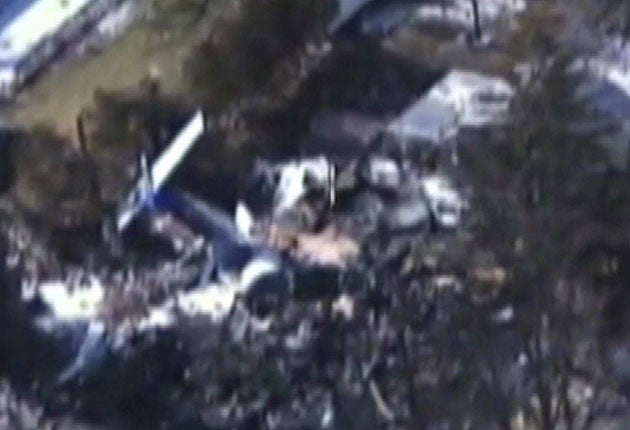'I thought if that's a plane, it'll hit something. Then the ceiling fell in'
Woman who survived Buffalo disaster speaks of the moment Continental airliner crashed into her home

The woman who, with her daughter, survived the terrible inferno when a commuter aircraft crashed on to her house outside Buffalo, in upstate New York, said yesterday that she had been watching TV and that, as soon as she heard the approaching aircraft outside her window, she knew it was in trouble.
"Planes do go over the house, but this one sounded really different, louder, and I thought to myself, 'If that's a plane it's going to hit something,'" explained Karen Wielinski.
Last night it emerged the plane had been on autopilot when it crashed, breaching federal safety guidelines and the airline's own policy that pilots fly manually in conditions as icy as those in the area at the time.
Mrs Wielinski's husband, Doug, had just left the sitting room for the dining room at the time of impact. He died when the aircraft struck along with all 49 people on board. For his wife and daughter, however, something close to a miracle occurred. Karen sensed disaster was near but had no time to react.
"The next thing I knew, the ceiling was on me. I didn't think I was going to get out of there. I thought, 'This is it,'" the 57-year-old told local radio.
"I was panicking a little but trying to stay cool and happened to notice a little light to the right of me. I shouted first in case anybody was out there, and then just pushed what was on me off and crawled out the hole. The back of the house was gone, the fire had started, I could see the wing of the plane and Jill was over to the side, crying of course, hysterical."
Crash investigators, meanwhile, resumed the grisly task of sifting through the wreckage of Flight 3407 yesterday as well as the Wielinski house amid new indications that the aircraft, a 74-seat turboprop, lost all aerodynamic lift.
A team of 150 investigators were at the site in Clarence Center, a suburb of Buffalo, as work began to separate the wreckage of the house from that of the aircraft. Officials said they had removed 15 bodies.
The ferocity of the fire after the crash coupled with the relatively small area of impact at first suggested the plane had nosedived into it. Now investigators believe the aircraft almost pancaked on to it.
Officials with the National Transport Safety Board, NTSB, revealed that the plane, a Dash-8 Q400 owned by Colgan Air and flying under the colours of Continental Connection, also spun round at the last moment.
While experts continued to analyse the data and voice recorders retrieved from the site, officials said it seemed clear that after pushing through mist and light snow on its way in the dark from Newark towards Buffalo the plane had lost forward motion at the time of the crash on Thursday night. The pilots had earlier discussed "significant" ice build-up on the wings and windscreen.
Two months ago, the NTSB advised pilots to fly manually in icy conditions. "You may be able in a manual mode to sense something sooner than the autopilot can sense it," said Steven Cheleander, the chief NTSB official at the site. Additionally, the black boxes confirmed that systems in the cockpit designed to warn pilots of the risk of stalling had been activated.
Mr Chealander warned against making early assumptions. He added that the work to resolve the mystery of Flight 3407 was still in the very early stages. "I know this seems as though this is going to be painstakingly slow, but unfortunately, we're not like ... a CSI show on television where we can solve it all in one hour," he warned.
The work at the crash site was made difficult because water poured over it to douse the fire after the crash had frozen by Saturday. Officials said they hoped to complete the work at the site by Wednesday before an expected snowstorm.
Join our commenting forum
Join thought-provoking conversations, follow other Independent readers and see their replies
Comments